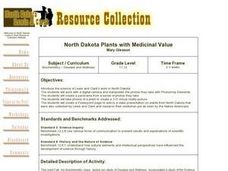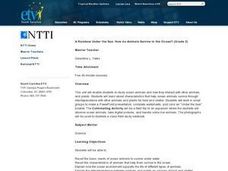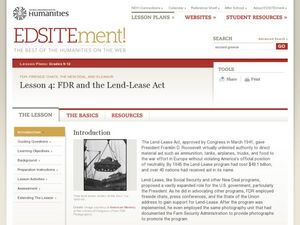Curated OER
Grow Your Own Grub
Learners create a recipe book. In this produce lesson, students watch a selection of the harvest animations from the BBC Dig In website, taste some of the vegetable and herbs they've been growing and discuss creating a class recipe...
Curated OER
Ecology of the Savanna-Forest Boundaries in Central Brazil
Students explore photosynthesis. In this photosynthesis lesson, students label parts of photosynthesis and take notes. Students conduct experiments on leaves, make observations and record their findings.
Curated OER
North Dakota Plants with Medicinal Value
Students use the internet and plant guides and other resources to identify plants and their medicinal importance as seen by the Native Americans. They view a copy of the Lewis and Clark journal that held photos of the plants of their...
Curated OER
To Eat or Not to Eat?
Students identify various parts of plants and determine which parts people eat. They conduct a celery stalk experiment in which they determine the value and use of the stem, and how it helps the plant to meet its needs. Students use a...
Curated OER
Memorable Cell Membrane
Learners investigate the components of a cell membrane. In this cell membrane lesson plan, students build a cell membrane model using toothpicks and candy to represent the parts of the membrane including the phospholipid bilayer and the...
Curated OER
Learning About Animal Shelters for Earth Day
Young scholars explore habitats. in this ecology and animal habitat lesson, students listen to the book A House is a House for Me by Mary Ann Hoberman. Young scholars discuss the basic needs of animals and go on a nature walk to observe...
Curated OER
A Walk in the Forest
Learners explore interrelationships among plants and animals. Students listen to Where to, Little Wombat? by Charles Fuge, and contribute words and phrases for a classroom animal and plant survival chart. Learners take a walk in a...
Curated OER
Recycle, Reduce, Reuse and Save a Tree
Students examine how to save and protect trees. In this conservation activity, students read books about the usefulness of trees, write ideas in their journals about how trees can be used, and make a book of ways to protect trees.
Curated OER
Demonstration Speech: How to Prepare to Give a Demonstration
Your class can practice public speaking by demonstrating an original recipe or how-to project. They must include images and speak for at least five to ten minutes. This is a very well outlined lesson plan that will be comprehensive for...
Curated OER
Growth and Changes in Plants
Young scholars investigate the growth and changes in plants. They view a video and discuss the changes in plants. They work in small groups to demonstrate vocabulary words to the class. They visit a green house and take pictures of...
Curated OER
Understanding Interactions Among Local Species and the Local Environment
Students examine the differences between biotic and abiotic factors, explain the difference between habitat and niche and compare how organisms get their nutritional needs. In this local environment lesson students trace the path...
Curated OER
A Rainbow Under the Sea: How do Animals Survive in the Ocean?
Second graders read books, watch videos, complete worksheets and participate in class discussions about ocean animals. They, in groups, design PowerPoint presentations on selected marine animals.
Curated OER
Finding Caterpillars
Students examine how animals protect themselves from predators and camouflage themselves. They participate in a simulation in which they locate red and green yarn "caterpillars," organize their data, and generate a bar graph using...
Curated OER
Classmate Grid
Students interview classmates and record their findings on a coordinate grid using Inspiration or Kidspiration and digital cameras. This lesson plan is technology-based and includes resource links.
Curated OER
Look Up - Birds
Students investigate the concept of birds. They identify five different types of birds and name the characteristics that make them different than other living things. Students also name the different parts of the bird and how they are...
Curated OER
Aloha, Hawaii!
Young scholars read the Hawaiian version of The Three Little Pigs, to study cultures and traditions of the island. They gather and study resources about the culture, people, and endangered species of Hawaii.
Curated OER
Candy Cane Chemistry
Fourth graders, in groups, examine the effect of heat on bonding forces by doing laboratory work.
Curated OER
La Influencia Latina en Nuestra Comunidad (The Latino Influence in our Community)
Students visit a grocery store to create a list of Latino products. They take photographs of areas in their community that demonstrate the latino population. Students research community services available to the Latino population. They...
Curated OER
Pumpkins, Pumpkins, Pumpkins
Students identify and interpret the lifecycle and parts of the pumpkin. Students utitlize interactive ways to discover this process. Students create a big book of their own by researching further information about pumpkins and what...
Curated OER
Life Cycle of the Butterfly
Students observe and analyze the life cycle and metamorphosis of the Painted Lady Butterfly. They write observation journal entries three times a week and summarize what they observed. Using KidPix computer software they create pictures...
Curated OER
FDR and the Lend-Lease Act
High schoolers analyze primary source documents and photographs to analyze the implications of the Lend-Lease Program. In this research lesson plan, students read and discuss letters and speeches related to the Lend-Lease Act, evaluate...
Curated OER
Venn Diagram: Gauguin Self-Portraits
In this Venn diagram worksheet, students compare 2 self-portraits of Gauguin, then use pictures from magazines to create their own "self portrait."
Curated OER
Asha's Village
Students compare and contrast their own culture with an Indian girl named Asha. In this culture lesson plan, students read, look at pictures, and make inferences.
Curated OER
Hero Holiday and Portfolio Completed
Students summarize the unit on heroes and present picture books to younger students. In this hero instructional activity, students compile their portfolios, in which they have presented heroic characteristics of their own...

























